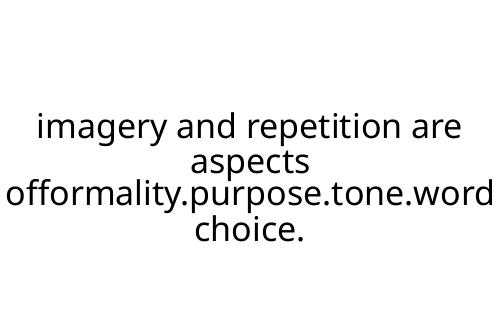imagery and repetition are aspects offormality.purpose.tone.word choice.
Imagery and repetition are aspects offormality.purpose.tone.word choice. If you’re puzzling over how these literary devices fit into the big picture of writing, you’re not alone. Writers at every level encounter debates about style, effect, and clarity. Here’s a direct look at why imagery and repetition matter, and how they connect to formality, purpose, tone, and word choice.
Understanding Imagery and Repetition
At their core, imagery and repetition are tools writers use to shape meaning and evoke emotion. Imagery appeals to the senses—painting mental pictures with descriptive words—while repetition stresses ideas or feelings by stating them more than once.
Whether you’re writing a formal essay, a persuasive article, or a creative story, these elements impact how a message is understood. Selecting vivid images or repeating a phrase can guide readers, set a mood, or underscore the main point.
How These Devices Affect Formality
Formality refers to the level of seriousness and adherence to conventions in your writing. Imagery and repetition don’t inherently raise or lower formality, but the way you use them does.
In highly formal writing, imagery might be subtle—think professional reports or academic essays. Repetition, when used sparingly, can emphasize critical data or findings. In less formal writing, such as blogs or narratives, imagery may be more colorful and repetition more conversational. Both should fit the context: too much of either can make writing feel forced or unprofessional.
Purpose Shapes Style
Why are you writing? Imagery and repetition are aspects offormality.purpose.tone.word choice that align with your goal. If you want to persuade, vivid imagery makes arguments memorable. Repetition reinforces your stance. If your purpose is to inform, you may use less imagery but repeat key data for clarity.
Understanding your aim helps you choose the right balance. For example, marketing copy is often heavy on both imagery and repetition, whereas business memos usually require restraint.
Tone and Word Choice Go Hand in Hand
Tone is your attitude on the page. Word choice—the vocabulary selected—shapes that tone. Imagery and repetition affect both. If you want to sound joyful, you select bright, positive imagery and repeat uplifting ideas. Serious tone? Opt for precise language and measured repetition.
The trick is to use words that match your intended mood, keeping imagery and repetition in check. Striking the right note depends on knowing your audience and your message.
Practical Tips for Writers
- Choose imagery that makes your point clearer, not just prettier.
- Use repetition for emphasis, but avoid overdoing it. Too much repetition can bore or annoy readers.
- Match your style to the level of formality your genre demands.
- Always keep your purpose and audience in mind.
Final Thoughts
Imagery and repetition are aspects offormality.purpose.tone.word choice that no writer can ignore. They’re flexible, powerful tools—when used with intention and care. Think about your goal, pick your words wisely, and use these devices to support, not distract from, your message. That’s good writing—plain and simple.


 Sienna Lyne
Author
Sienna Lyne is the talented author behind Bet Wise Daily's engaging and informative content. With a background in journalism and a keen interest in the gambling world, Sienna excels at crafting articles that are both insightful and accessible. Her work covers a wide range of topics, from the latest casino developments to in-depth features on gambling strategies. Sienna's meticulous research and sharp writing skills make her a valuable asset to the team, providing readers with trustworthy information and thought-provoking analysis.
Sienna Lyne
Author
Sienna Lyne is the talented author behind Bet Wise Daily's engaging and informative content. With a background in journalism and a keen interest in the gambling world, Sienna excels at crafting articles that are both insightful and accessible. Her work covers a wide range of topics, from the latest casino developments to in-depth features on gambling strategies. Sienna's meticulous research and sharp writing skills make her a valuable asset to the team, providing readers with trustworthy information and thought-provoking analysis.
